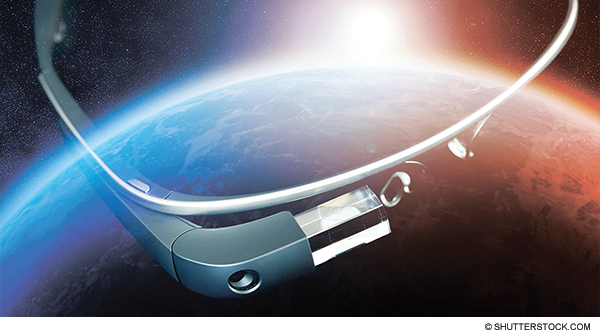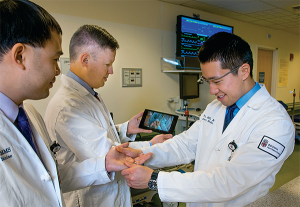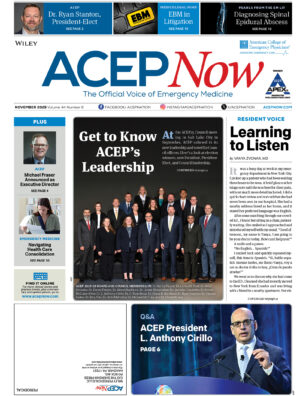
Last September, emergency physicians at Beth Israel Deaconess Medical Center in Boston began testing a new technology that may forever change the way they deliver patient care. It weighs less than a pound, instantly retrieves critical patient data and clinical information, and takes pictures and records videos that other physicians can see in real time.
Explore This Issue
ACEP Now: Vol 33 – No 07 – July 2014Google Glass made its debut last year and is already in the hands of emergency physicians at Beth Israel, Rhode Island Hospital in Providence, and Brigham and Women’s Hospital in Boston. The wearable technology is a touch- or voice-activated computer featuring an optical face-mounted display. Emergency physicians believe the device can serve as an effective diagnostic, decision-support, and patient-tracking tool, but just like with any new technology, they say it needs to evolve to reach its full potential.
At Beth Israel, a handful of emergency physicians are integrating the HIPAA-compliant device into patient care, said Terrance Lee, MD, a resident physician in emergency medicine at Beth Israel. Dr. Lee and others worked with San Francisco–based Wearable Intelligence to develop an application that would display everything from patient triage vitals to lab and radiology results on Glass.

Rhode Island Hospital emergency physicians Peter Chai, MD, Paul Porter, MD, and Roger Wu, MD, (left to right) test Google Glass’s real-time video capabilities.
Just as impressive, the device’s camera scans QR (quick response) codes displayed on the outside of every patient room. The patient’s information instantly pops up on Glass. Although the technology enables physicians to quickly access data between patient rooms and spend more time at the patient’s bedside, Dr. Lee said reactions have been mixed.
“Some [physicians] need to be more familiar with the device, especially those not tech-savvy or comfortable with computers, while others are trying it out and making it work for them,” he said. “Anecdotally, we’ve had great responses from patients of all ages … they’re intrigued by Glass and how we’re using it.”
Predicting Plenty of Potential
Before it was used in a live clinical setting, Google Glass was tested at the simulation center at Brigham and Women’s Hospital for five months. Charles Pozner, MD, an emergency physician who runs the center, and other emergency physicians have been working with several IT partners and universities, including MIT, in hopes of introducing a more mature product to the clinical environment.
“We want to be able to integrate it with some of the equipment that we use within the [emergency] department,” he said. “We’re trying to figure out what is important to put on the screen in order to make [it] the most efficient … if you put too much on the screen, ultimately, you will overwhelm the clinician and maybe make things even worse.”
Likewise, Mike Stone, MD, FACEP, chief of the division of emergency ultrasound in the department of emergency medicine at Brigham and Women’s, has been working with another software developer to display ultrasound images on Glass while performing ultrasound procedures. While physicians must use both hands to perform ultrasounds, he explains that they also switch their gaze multiple times from the procedure to an ultrasound screen.
“There’s nothing more discouraging to patients than watching a doctor’s face buried in a keyboard”
—Paul Porter, MD
“A real-time, heads-up display during the procedure enables you to continue looking at the patient while performing the procedure,” said Dr. Stone, adding that accurate hand placement is critical for obtaining quality images. With Google Glass, he said, a physician can see what trainees in another room are seeing and help guide their hands.
Meanwhile, integrating the device with existing technology is proving challenging, said Dr. Pozner. He said “thoughtful development” of Google Glass is critical, especially where doctor-patient interactions are concerned.
“If we approach it strictly from a technology [perspective], we will fail,” Dr. Pozner said. “If we approach it from how the technology can make things better and how it can improve the doctor-patient relationship, we’ll have much more chance of success.”
Since February, Rhode Island Hospital has been testing a HIPAA-compliant stripped-down version of Google Glass for real-time audio-visual dermatology consults with patients. This study is part of a larger program at Brown University to train the next generation of doctors in the safe and appropriate use of technology in health care, said Paul Porter, MD, a physician in the emergency departments of Rhode Island, Hasbro Children’s, and The Miriam hospitals and associate professor of emergency medicine at Brown University.
“There’s nothing more discouraging to patients than watching a doctor’s face buried in a keyboard,” he said, adding that another study will investigate the efficacy of emergency medical service providers using Google Glass with stroke victims.
Other than a short battery life, occasional overheating, and a handful of dropped calls, Dr. Porter said physicians and patients have been extremely satisfied with Google Glass. So far, only one patient declined its use during her care for reasons unknown.
He said the technology helps emergency physicians put their eyes back on the patient instead of a desktop screen, which enhances physician-patient relations. “And that’s good,” Dr. Porter said. “That’s very good.”
Carol Patton is a freelance journalist based in Las Vegas.
Pages: 1 2 3 | Multi-Page





No Responses to “Google Glass May Help Emergency Physicians Improve Patient Care”